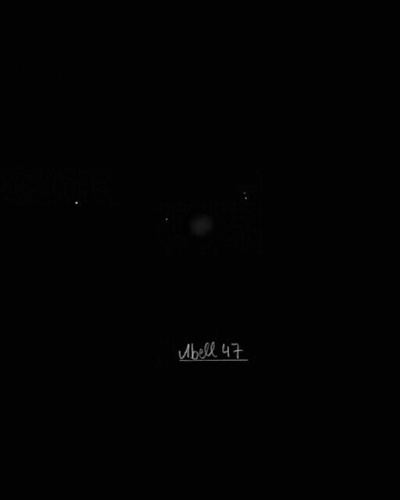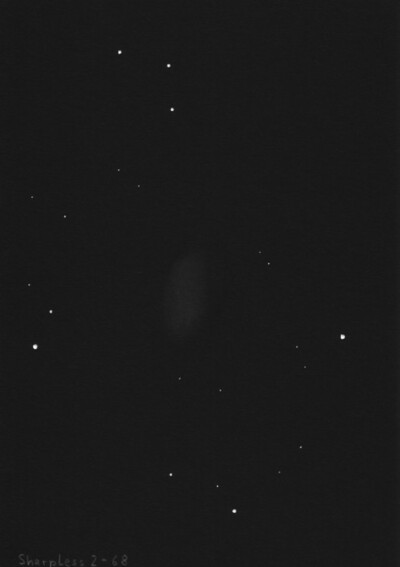The constellation of Equator, which in summer rises in our country all above the horizon. It is the only one of the 88 constellations that is divided: it is formed by two separate parts: the Head and the Tail of the Serpent, between which lies Ophiuchus. Yet the Serpent is listed as a single constellation. The two parts of the constellation are situated around the celestial equator and at first glance might appear to be similar in many ways. However, the opposite is true. The head of the Serpent is further away from the Milky Way and is therefore rich in extragalactic objects - galaxies, but most of them are relatively faint. Of the few globular clusters, M5 stands out, competing with M13 for the title of the most beautiful globular cluster in the northern sky. The tail of the Serpent lies virtually inside the Great Rift, which divides the Milky Way into two streams. Mainly due to its dark dust clouds, this part contains fewer of the open clusters and nebulae we are used to seeing when observing constellations located in the Milky Way's rich fields. However, one object is exceptional - the Eagle Nebula, an emission complex within which lies an open cluster.
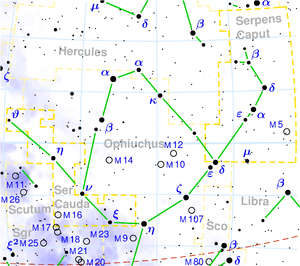
Unukalhai (α Ser) - The brightest star of the constellation has a magnitude of 2.65. It is located 74 light-years away from Earth and its luminosity exceeds that of the Sun by 35 times. It belongs to the spectral class K2 and is an orange giant.
β Ser - A binary star, with its yellow and blue components having magnitudes of 3.7 and 9.9, respectively, and separated by 31". They can be resolved even with a small telescope. The system is located 155 light-years away from Earth. At a distance of 201", we can still observe a component with a magnitude of 10.7.
δ Ser - The close pale yellow companions have magnitudes of 4.2 and 5.2. They orbit each other with a period of 3.170 years. In the sky, we perceive them as a pair with a separation of 4.4". In a large telescope, we can also see two faint companions with magnitudes of 14.7 and 15.
Alya (θ Ser) - Double star on the eastern edge of the constellation. The pair of blue-white stars with magnitudes 4.6 and 5.1 are separated by 22.3", so a regular telescope is sufficient for their resolution. Both belong to the spectral class A5 and are physically related. They are located at a distance of 86 light-years.
5 Ser - unequal pair of yellow 5.1 magnitude and red 10.1 magnitude components separated by 11.2". In the field of view, at a separation of 127", there is a companion of magnitude 9.1 and on the edge, a globular star cluster M5.
R Ser - A variable star of the Mira type located 10 degrees from the star Unukalhai between β and γ Ser, which reaches a maximum magnitude of 6, but disappears from view even with averted vision during its minimum, as it drops to 13.4 mag. The period of its brightness variation is approximately 1 year - 357 days.
59 Ser - The unevenly bright but attractive double star of yellow 5.3 magnitude and white component of 7.6 magnitude is located in a particularly dark area of the Great Rift. The separation between this pair is 3.8".
Struve 2303 - A close binary star observed in the field of the Milky Way interwoven with dark nebulae. Components of 6.6mag and 9.1mag at a separation of 2.1" are a very good test of quality for small telescopes and require a minimum of 150x magnification.
M 5
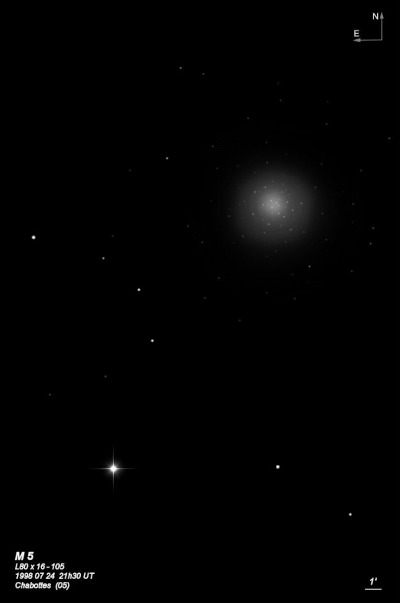
Gottfried and Maria Kirch discovered M5 = NGC 5904 = h1916 on 5 May 1702. Maria's diary (translated by Leos Ondra) mentions "By such searching [for the comet then visible] my husband found by this with just this 3 Sch. tube, high over Mu [Serpentis] a nebulous light, it had many other fine stars around it, but one stood particularly by the tube above it about thus: [sketch follows]." Charles Messier independent found it on 23 May 1764.
William Herschel's first observation using his 6.2-inch (7-ft telescope) was on 4 Mar 1783: "It consists of stars; they are however so small that I can but just perceive some, and suspect others. 1810 (power?), the globular figure is visible." Using his 18.7" on 5 May 1785 (sweep 409) he recorded, "a very compressed very beautiful, and large cluster of small stars of various sizes, and of a red colour. For about 2 or 2.5' they are extremely compressed in the center; and the pretty regularly scattered stars extend to about 7 or 8' diam." Then there are besides many more irregularly scattered at a greater distance; especially one branch, which extends in a direction of about 15 or 20 degrees sp and some of the stars of this branch are rather larger than the rest." On 24 Feb 1787, he logged "The most beautiful, extremely compressed cl of small stars; the greatest part of them gathered together into one brilliant nucleus; evidently consisting of stars, surrounded with many detached gathering stars of the same size and colour."
While being instructed by his father on his first sweep of 29 May 1821, John Herschel logged, "a most beautiful cluster, vmbM, very compressed, round, the stars various sizes scattered." The sweep was later numbered 53, out of date. His regular sweeps began in 1825.
200/250mm - 8" very high resolution of large, intense outer halo, many stars at edge of small core.
300/350mm - 13.1" spectacular resolution of several hundred stars from the outer halo to the core, rows of long streamers.
400/500mm - 17.5" (5/10/86): very bright, very large, extremely dense, edge-to-edge resolution of several hundred stars across 22' field (not possible to count), many stars arranged in arcs and streamers. Strong even concentration to a large very bright core. Third best globular cluster from northern California (5th brightest integrated magnitude) and can be glimpsed naked-eye in as a small fuzzy glow in dark skies. Located 22' NW of 5 Serpentis (∑1930 = 5.2/10.2 at 11") and the star is more prominent than the globular.
Naked-eye - (7/26/06): M5 was just visible naked-eye but the nearby mag 5 star (5 Ser) detracts from the observation. The globular appears as a faint, very small fuzzy glow close NW of the star.
(1/21/12): confirmed naked-eye from Mauna Kea visitor center though the nearby mag 5 star is much more prominent.
Notes by Steve Gottlieb
M 16
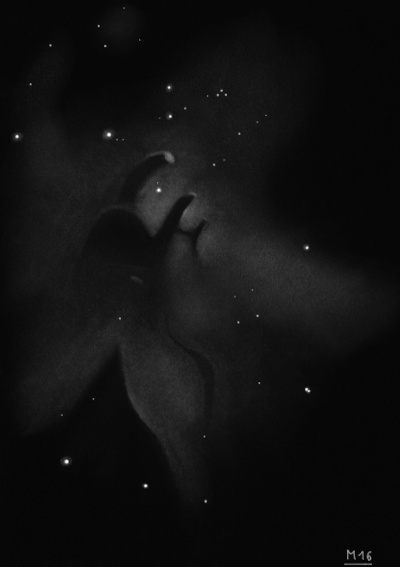
Philippe Loys de Chéseaux discovered M16 = NGC 6611 = h2006 in 1745-46 and reported it as a star cluster to the French Academy of Sciences. Charles Messier independently found it on 3 Jun 1764 and stated "appears nebulous in a small telescope" and "enmeshed in a faint glow" but this appearance was due to the poor resolution of the stars in his telescope - not the involved nebulosity. William Herschel, observing on 30 Jul 1783 with his small 20-foot (12-inch reflector), described "Large stars with small ones among them; within a small compass I counted more than 50, and there must be at least 100 without taking a number of straggling ones, everywhere dispersed in the neighborhood." So, Herschel didn't note any nebulosity either.
Isaac Roberts discovered the nebulosity in the "Eagle Nebula" on a photographic plate taken in 1894 and it was catalogued as IC 4703. But Wolfgang Steinicke claims that Étienne Léopold Trouvelot made a visual discovery of the nebulosity in 1876 with the 26-inch refractor at the USNO! Robert Innes, observing in 1914 at the Union Observatory in Johannesburg, reported "with the 9-inch refractor the nebula is just visible and it fills the perimeter of the cluster with faint extensions beyond."
300/350mm - 13.1" (8/17/85): a thin dark "finger" extends towards the cluster, positioned just south and beyond the two bright mag 9 stars near the center. This is an extension of the wider projection seen previously several times and which is better defined along the south edge.
13.1" (8/15/82): the "Eagle Nebula" is a fairly bright 30' nebulosity in a striking outstretched eagle shape with a bright scattered cluster superimposed. There is a considerable contrast gain to the nebulosity using a UHC or OIII filter. With a UHC filter, a dark projection (called the "Star Queen") enters on the SE edge of the nebula and extends inward to the west. The cluster members surrounding the "head" of the eagle include ten mag 8-10 stars and a bright pair of mag 8.5 stars (8.2/8.8 at 27"). A dark triangular wedge is visible off the north side.
13.1" (5/26/84): dark protrusion fairly easy at 88x.
Notes by Steve Gottlieb
IC 4756
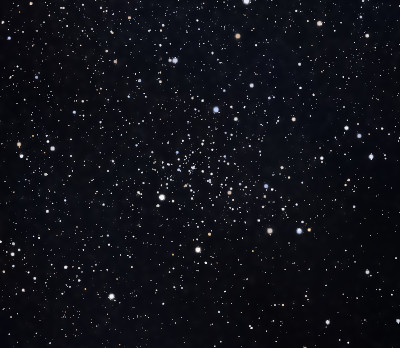
10x50 binoculars (9/9/83):very bright, very large, consists of mag 7 and fainter stars. Includes many chains and knots over a one degree field! Larger but not as conspicuous as nearby NGC 6633 in Ophiuchus. Easy naked-eye cluster in dark sky.
Solon Bailey found IC 4756 in 1896 on a plate taken with a 1" Cooke lens at the Arequipa station in Peru (Annals of Harvard College Observatory, Vol LX, No VIII, 1908) and is credited with the discovery in the IC2. But it was discovered visually by Reverend Thomas Webb by 1859 with his 3.7" Tully refractor. In the listing for NGC 6633 in his "Celestial Objects for Common Telescopes" (1859) Webb wrote, "Between it NGC 6633] and Theta, nearer the former, is a beautiful large cloud of stars, chiefly 8 or 9 mag., a nearer part, apparently, of the Galaxy: visible to the naked-eye, and requiring a large field." The nickname "Graff's Cluster" comes from German astronomer Kasimir Graff, who independently discovered it in 1922.
400/500mm - 17.5" (7/26/95): overfills 50' field with 20 Nagler. Contains roughly 70 stars brighter than mag 11 and too many faint stars to count. There are two mag 6.5 stars near the northwest and southeast ends of the cluster (the latter star is not physical member) at the edges of the field (46' separation). There are no rich subgroups or central concentration but many stars are arranged in long chains and curving loops. The most prominent is a long chain oriented NW-SE through the center. Visible as a naked-eye patch at the edge of the Milky Way.
Notes by Steve Gottlieb
NGC 6539
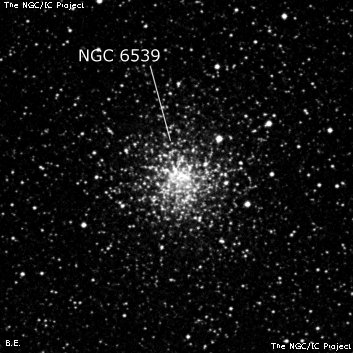
Theodor Johann Christian Brorsen discovered NGC 6539 = Au 39 in 1856 (probably Sept) at the Senftenberg Observatory in the present-day Czech Republic, probably using a 9.4-cm comet-seeker. Arthur Auwers observed this globular on 10 Oct 1860 with the Konigsberg 6-inch refractor and reported (in the notes to his 1862 list of new nebulae) that it "looked faint, but pretty well at 65x; it appears to be a faint star group of about 3' diameter, centrally surrounded by numerous stars 12m." (translation by Wolfgang Steinicke). NGC 6539 is one of the brighter southern objects that John Herschel missed.
200/250mm - 8" (6/22/81): faint, moderately large, very diffuse, no resolution. This globular straddles the Serpens/Oph border, 44' NE of Tau Ophiuchi, an excellent 1.5" double star.
400/500mm - 17.5" (8/10/91): fairly faint, moderately large, 3' diameter, round, diffuse, broad weak concentration. A number of stars are very near including a mag 12.5 star off the NW edge and a fainter mag 13.5 star off the SE edge. In addition, an extremely faint 15th mag star is resolved near the NW edge and a mag 15 star is visible near the center but no other resolution was evident.
600/800mm - 24" (7/30/16): at 260x; fairly faint, moderately large, round, ~3' diameter, very weak concentration. A brighter mag 12.8 star is just off the northwest edge and a mag 13.5 star is off the southwest edge. The cluster was very lively at 432x and several faint to extremely faint stars were resolved around the edges of the halo including a few easy ones just off the west side. Several very faint to extremely faint stars scintillate over the core and main portion of the halo, popping in and out of view with the seeing, though only a couple of these were consistently visible.
Notes by Steve Gottlieb
NGC 6604
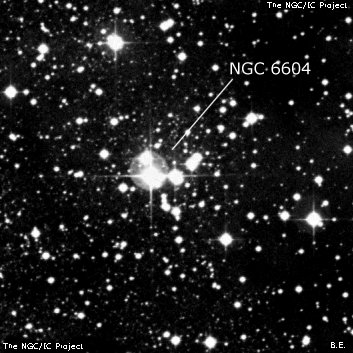
16x80 finder (8/10/91): very large, very faint emission haze (Sh 2-54 = Gum 84) surrounding a very large group of stars, improves with UHC filter. The Eagle Nebula was very prominent in the field to the south. On the north side of this large HII region is a small brighter knot = Simeis 3-132 that was visible in the 17.5" at 64x using a UHC filter as a moderately bright, 3'x2.5' glow, slightly elongated N-S. The eastern side of this HII knot has a sharper, linear border. Also viewed at 220x unfiltered and a group of a half dozen mag 12-13 stars extended N-S in a string are superimposed near the eastern boundary. This obscure, but relatively easy nebula is located 30' N of open cluster NGC 6604 on the north end of Sh 2-54.
William Herschel discovered NGC 6604 = H VIII-15 = h3740 on 15 Jul 1784 (sweep 238) and noted "a cluster of coarsely scattered stars." His position is roughly 9' too far north-northeast. JH made the single observation (sweep 617) "a poor cl class VIII having coarse stragglers to a great distance. The chief * 7m taken."
400/500mm - 17.5" (8/10/91): at 140x appears as a prominent 2' arc of five stars including a mag 7.5 star and a double star on the southwest end. Surrounding this arc is a 5' group of roughly two dozen stars elongated N-S, which includes two faint pairs. My observation of the surrounding emission complex Sh 2-54 is appended below.
Notes by Steve Gottlieb
NGC 5921
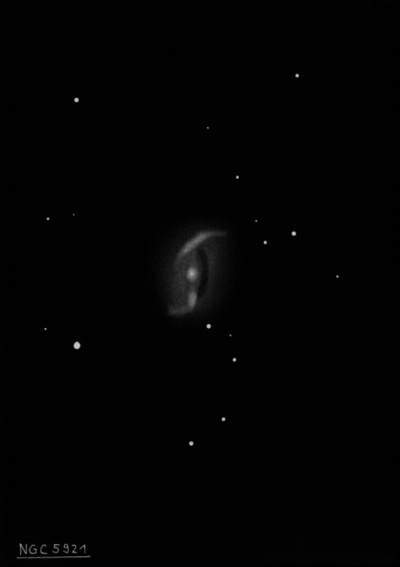
William Herschel discovered NGC 5921 = H I-148 = h1919 on 1 May 1786 (sweep 561) and recorded "cB, cL, bM, iR. Stars scattered over and about it; not belonging to it." His position is accurate. On 17 Apr 1855, LdR's assistant R.J. Mitchell, logged "suspect spiral like an 'S'. Mr J. Stoney saw the np branch with considerable certainty, the sf one not so sure."
A photograph (3-hour exposure) with the Crossley reflector was included in the October 1912 Publications of the Astronomical Society of the Pacific. Curtis described NGC 5921 as a "very interesting spiral. Fairly strong nucleus, about which is an oval 1.8' long, whose longer axis is crossed by a straight lane of matter; from the ends of this oval spring the two main whorls of the spiral; other fainter whorls are visible."
400/500mm - 17.5" (7/16/93): fairly bright, fairly large, elongated 3:2 N-S, 2.0'x1.4', small bright core dominates, stellar nucleus. Located 2.9' WNW of a mag 9.5 star. A mag 12 star is just at the SW edge 1.1' from center. This star is at the end of a distinctive arc of four mag 11-12 stars leading to the galaxy on the south side.
600/800mm - 24" (7/25/14): at 260x, this multi-armed barred spiral appeared bright, fairly large, elongated 3:2 ~N-S, sharply concentrated with a striking, very bright core. A slightly brighter bar (fairly low contrast) extends SSW to NNE. The very beginning of a spiral arm is evident as an elongated glow at the north end of the bar, extending a very short distance to the northwest. The view was improved at 385x with a strong hint of a second spiral arm beginning at the south end of the bar and starting to bend east. Contains a bright, sharp stellar nucleus. A mag 10 star is 3' SE and a mag 12 star is at the southwest edge.
900/1200mm - 48" (5/1/19): at 545x; superb barred ring spiral, very sharply concentrated with an intense, round nucleus. The central 1.25' bar was easily visible extending SSW-NNE, and displayed a pretty even surface brightness. A fairly low contrast circular ring was visible enclosing the bar and nucleus. The northern spiral arm was attached at the north end of the bar and curled clockwise, extending west for ~1.5'. A prominent southern arm was fairly straight as it extended 1.25' ESE from the south end of the bar (at a right angle). The diffuse eastern part of the halo had a low, but irregular surface brightness. A mag 12.0 star is at the southwest side, 1.2' from center and a mag 10.3 star is 2.9' SE. A curve of stars extends directly south of the galaxy and a number of stars are close west.
UGC 9830, located 36' SSE, appeared faint, fairly large, extremely thin edge-on, ~10:1 SW-NE, ~1.5''x0.15', very low nearly even surface brightness. A mag 13.6 star is attached at the east edge near the center and detracts from viewing.
Notes by Steve Gottlieb
NGC 6118
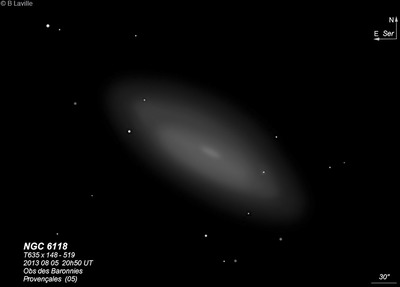
William Herschel discovered NGC 6118 = H II-402 = h1953 on 14 Apr 1785 (sweep 400) and recorded "F, cL, E from sp to nf, about 3' l and 2' broad, r." John Herschel made a single observation: "eF; vL; oval; 3' l, 2' br; cloudy; 3m preceding nearly in the parallel is a fine double star [STF 2033]." NGC 6118 is often mentioned as one of the most challenging objects on the Herschel 400 list.
300/350mm - 13.1" (6/4/83): moderately large, elongated WSW-ENE. This is a very diffuse object with no concentration and ill-defined edges. Located 17' SW of mag 6.2 SAO 141129 in the SE corner of Serpens Caput.
Notes by Steve Gottlieb
NGC 6070
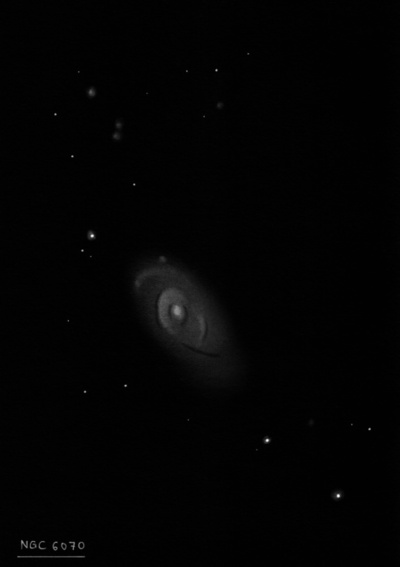
William Herschel discovered NGC 6070 = H III-553 = h1947 on 3 May 1786 (sweep 562) and recorded "cF, iF, 4 or 5' long, 2 or 3' br." His position and description matches UGC 10230. JH called this galaxy "F; L; pmE; vgbM; 2 1/2' long."
300/350mm - 13.1" (6/4/83): fairly large, diffuse, elongated ~E-W, almost even surface brightness. A mag 7 star is 7' N.
400/500mm - 17.5" (6/11/88): fairly bright, large, oval 2:1 SW-NE, broad moderate concentration. Brightest of trio with NGC 6070B 4.3' NE and 6070C 5.6' NE. Located 7.9' SW of mag 7 SAO 121396.
600/800mm - 24" (6/28/14): fairly bright, large, elongated 2:1 SW-NE, 2'x1', contains a large brighter core, fades out around the periphery. A very faint "star" seen near the northeast tip is actually a compact HII region labeled as region IV in the 2010 paper. Located 8' SE of mag 6.7 HD 145204.
NGC 6070 is the brightest in a trio with NGC 6070B = CGCG 023-018 (double) 4.2' NE and NGC 60670C = PGC 1175364 5.6' NE. NGC 6070B appeared very faint, small, elongated 2:1 ~N-S, low surface brightness. This is a close double system and the noted elongation implies both systems were visible, but not individually resolved. NGC 6070C was extremely faint, very small, round, 12" diameter. The fainter companions are much more distant at ~590 million l.y., compared to NGC 6070 (~100 million l.y.).
900/1200mm - 48" (5/9/18): at 375x; even in poor seeing NGC 6070 revealed three spiral arms or arcs of arms as well as a couple of HII knots. The galaxy appeared bright, large, elongated nearly 2:1 ~SW-NE, ~3'x1.5'. An inner spiral arm was visible on the NE side of the bright core. It showed a "hard" outer edge that defined the arm and contrasted with an obvious darker gap (dust) that was between this arm and an outer spiral arm. The outer arm seemed to emerge just north of the inner arm and gently curved counterclockwise towards the east and bending south near its tip. This outer arm ended at a very faint, small HII knot labeled as region I in the 2010 paper "Giant HII regions in NGC 7479 and NGC 6070". Just outside the northeast curve of this arm was a second, slightly brighter HII knot, 6"-10" diameter (identified as region IV). Another inner spiral arc was symmetrically placed to the SW side of the core. It was pretty ill-defined, though, and lacked a sharp edge.
NGC 6070B is a close double system 4.3' NE of NGC 6070. The cores were easily resolved at 16" separation N-S. The southern component (NGC 6070B NED2) was larger and appeared fairly faint, round, 0.4' diameter, small bright core. The northern component (NGC 6070B NED1) was also fairly faint and round, but smaller - about 15" diameter. NGC 6070C, just 1.3' NE [PA 35°], was brighter than either component of NGC 6070B and appeared moderately bright, fairly small, round, 20" diameter, moderately high surface brightness.
Notes by Steve Gottlieb
NGC 5953
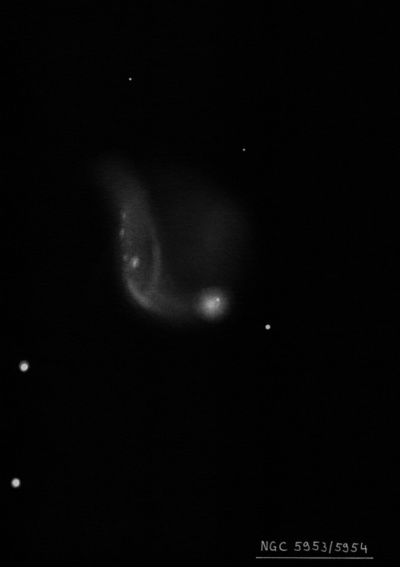
William Herschel discovered NGC 5953 = H II-178 = h1927, along with NGC 5954, on 17 Apr 1784 (sweep 200) and described both in sweep 200 as "Two, vS, stellar nebula, very near each other; the southern one [NGC 5953] is the largest and their nebulosities run into each other. 240x confirmed it." He also observed the pair on two later sweeps (571 and 720) and measured an accurate position (1' south). LdR (or assistant Bindon Stoney) logged "pB, the nf one NGC 5954] is larger and the light of a more diffused character; that of the preceding one [NGC 5953] is more concentrated. A small star precedes."
400/500mm - 17.5" (7/7/94): bright, very small, round, 0.8' diameter. Sharp concentration with a striking high surface brightness 20" core surrounded by a much fainter halo slightly elongated ~E-W. A mag 15-15.5 star is just visible at the SW edge 23" from the center. Forms a striking double system (Arp 91 = VV 244) with NGC 5954 attached at the NE edge, 46" between centers. NGC 5951 lies 16' SW.
600/800mm - 24" (6/8/13): very bright, moderately large, slightly elongated, ~45"x35", sharply concentrated with a very bright small core. A mag 15 star is at the SW edge. Forms a bright, partially overlapping double system (Arp 91) with NGC 5954 on the NE side.
Notes by Steve Gottlieb
NGC 6605
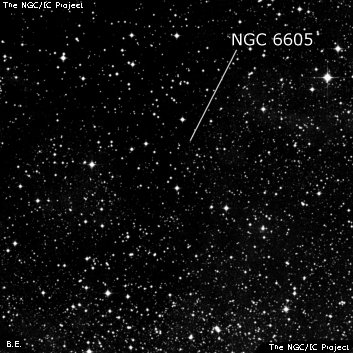
John Herschel discovered NGC 6605 = h2005 on 31 Jul 1826 and logged "A loose straggling cluster of stars 11...12m." There is nothing at his position but 2 minutes of RA preceding is a scattered group of bright stars that Corwin identifies as probably NGC 6605. Karl Reinmuth simply reported "no Cl" and RNGC classifies the number as nonexistent (Type 7).
400/500mm - 18" (8/27/05): at 73x, this is a very undistinguished group of 80-100 stars scattered over 20' and appears to be just a typical Milky Way field. Includes a mag 7.8 star (HD 167498) on the NW side and just NW of this star are a number of faint stars. Otherwise, there is a noticeable lack of any rich spots or concentration and the central region is noticeably lacking in stars. The only reason I can see Herschel may have been recorded this object is because it's somewhat detached in a low power field. Listed as nonexistent in the RNGC.
Notes by Steve Gottlieb
NGC 6535
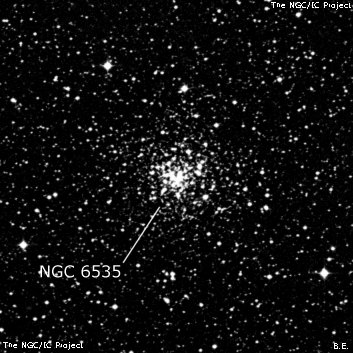
William Herschel discovered NGC 6535 = Au 38 on 24 Aug 1780 with his 6.2-inch reflector (used to discover Uranus) during his initial inspection of Flamsteed stars. According to Wolfgang Steinicke, who uncovered this observation ("a nebula with stars") in his Herschel research, this was the first nebula he discovered! As a result NGC 7009 = Saturn Nebula, found on 7 Sep 1782 with the same reflector, was his second discovery. The same night he also observed M8 ("a Nebula not marked in the map full of stars in via Lactea"), before being aware of Messier's catalogue.
John Russell Hind independently discovered NGC 6535 on 26 Apr 1852 (MN, 12, 208) with a 7-inch Dolland refractor at George Bishop's private observatory in London and recorded "a nebulous object which does not occur in any of the Catalogues of Nebulae hitherto consulted. It is very small and rather faint, perhaps 1' in diameter and is preceded a few seconds by a very minute hazy-looking star." Hind is credited with the discovery in the NGC. Auwers observed it with the 6-inch Heliometer at Königsberg Observatory and reported "pF, round, 2' diameter, gradually very slightly bM."
Based on photographs with the 30" reflector in 1914-16 at the Helwan Observatory, NGC 6535 was reported as a "small loose cluster of a few bright stars. No nebulosity."
400/500mm - 17.5" (8/10/91): moderately bright, roughly circular, 3' diameter. Three mag 13 stars and a mag 14 star are almost on a line oriented N-S on the west edge. Very mottled and granular appearance with an irregular outline. Can just steadily resolve a few very faint stars and another half a dozen extremely faint stars pop in and out of view over the core. Located within a rich star field.
600/800mm - 24" (7/30/16): at 500x; moderately bright and large, roundish, ~3' diameter, fairly weak concentration with a slightly brighter core. A mag 13 star is on the southwest side of the halo, two mag 13.5 stars on the west side and another near the northwest edge. A half-dozen stars additional stars are resolved in the halo with a few additional around the edges of the halo. A number more scintillate in and out of view, emerging for brief moments in better seeing, ~20-25 total seen in the halo. The core region includes another half-dozen stars with one standing out more prominently.
Notes by Steve Gottlieb
UGC 9829
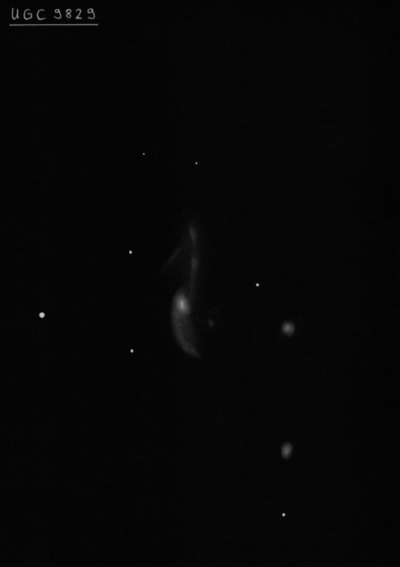
Although a merger or interaction must have taken place to create the distorted arms in UGC 9829, the two compact ellipticals appear undisturbed on the SDSS.
600/800mm - 24" (6/27/14): faint, small, slightly elongated (core), 15"x12". Often extremely faint extensions (arms) are visble extending NNW to SSE and increasing the dimensions to 30"x12". Brightest in a trio (KTG 61) with CGCG 021-081 1.6' WSW and CGCG 021-083 2.4' SSW.
24" (5/29/14): faint to fairly faint, fairly small, elongated 4:3 N-S, 0.4'x0.3'. The remarkable tidally stretched arms extending north and south were not seen.
900/1200mm - 48" (5/1/19): at 545x; this unusual galaxy contained a bright elongated core 0.3'x0.2'. A spiral arm was attached on the east side and was brightest near the root. It continues as a diffuse, low surface brightness extension to the south and curves slightly, convex to the east, for a total length of ~40". A second faint tidal arm is attached on the NW side of the core. This thin arm extended straight north for 1' with a brightening at the north end. A faint, broken section angling SE from the north tip was not seen.
Notes by Steve Gottlieb
NGC 5994
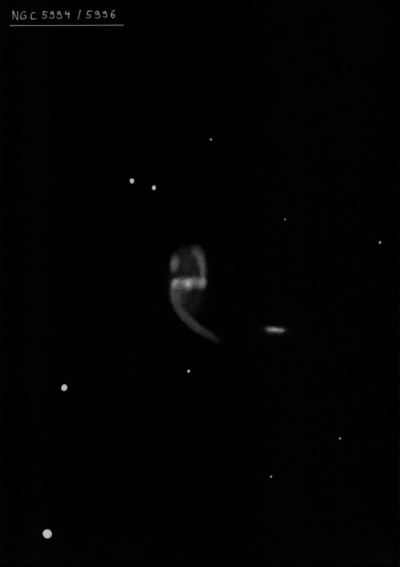
George Johnstone Stoney, Lord Rosse's assistant, discovered NGC 5994 on 9 Mar 1851. During an observation of NGC 5996 he noted a "small nebula preceding." This observation was not included in LdR's 1861 publication and the discovery was not included in either the GC or GCS. The rough NGC position is 34 seconds of RA too far west (no position was measured at Birr Castle).
400/500mm - 17.5" (5/14/88): fainter member of an interacting system with NGC 5996 (Arp 72). Very faint, extremely small. Appears as a barely non-stellar knot just 1.5' SW of the center of NGC 5996. A mag 14 star lies 1.3' SE.
900/1200mm - 48" (5/15/12): at 488x appeared fairly faint to moderately bright, small, elongated 2:1 E-W, 20"x10", gradually brightens to the center. This galaxy is the fainter member of the interacting pair Arp 72, and is situated just 1.5' from the center of NGC 5996. A spiral arm from the NGC 5996 hooks southwest towards NGC 5994, but the pair is not connected.
Notes by Steve Gottlieb
IC 1127
Considered the prototype of a megamaser with 98% of its emission in the infrared. In addition there is a large starburst of young stars.
Stephane Javelle found IC 4553 = J. 3-1368, along with IC 4554, on 25 Jul 1903. His position is at the south edge of Arp 220. Truman Safford made an earier discovery on 4 May 1866, but his RA for Sf. 7 = IC 1127 was 1 minute too large and Dreyer missed the equivalence IC 4553 = IC 1127. See Harold Corwin's and Malcolm Thomson's notes on this number.
400/500mm - 17.5" (4/7/89): fairly faint, almost round, even surface brightness. This is an interacting double system with an extremely faint "knot" or extension at the south end [elongated E-W on the POSS]. IC 4554 is a separate galaxy 2.2' SE of the double system observed.
600/800mm - 24" (6/16/12): fairly faint to moderately bright, fairly small, slightly elongated, uneven surface brightness and irregular appearance, though the core was not resolved into two components. Forms a pair with IC 4554 2.2' SE (not part of Arp 220 as generally assumed).
900/1200mm - 48" (5/1/19): at 375x; bright, large, contains a large uneven bright core. The halo is irregular with a hint of structure and extends mostly north of the core.
Notes by Steve Gottlieb
HCG 79
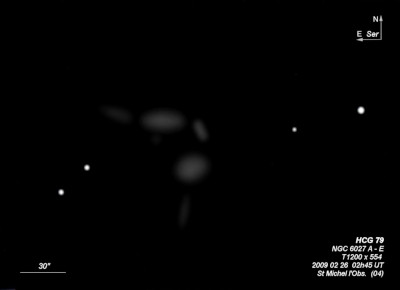
| Type | GALCL [E3] |
| RA | 15:59:12.9 |
| Dec | +20:45:06.0 |
| major_axis | 1.7' |
| mag | 11.3 |
| surface_bright | 99.9 |
Pal 5
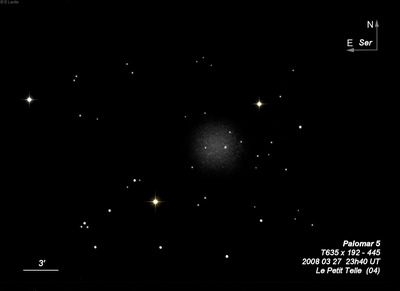
| Type | GC [XII] |
| RA | 15:16:06.0 |
| Dec | -00:07:00.0 |
| major_axis | 8.0' |
| mag | 11.8 |
| surface_bright | 16.1 |
HCG 74
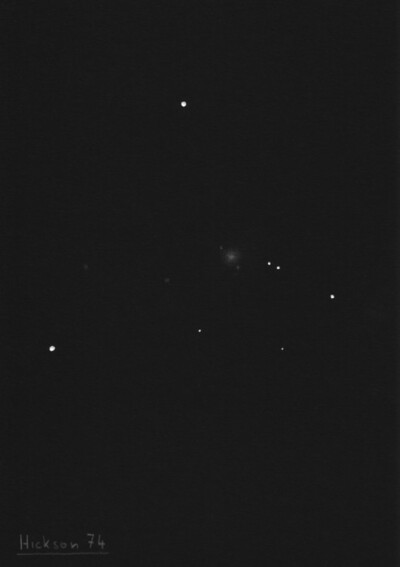
| Type | GALCL [E2] |
| RA | 15:19:28.3 |
| Dec | +20:53:37.0 |
| major_axis | 2.5' |
| mag | 12.1 |
| surface_bright | 99.9 |
HCG 76
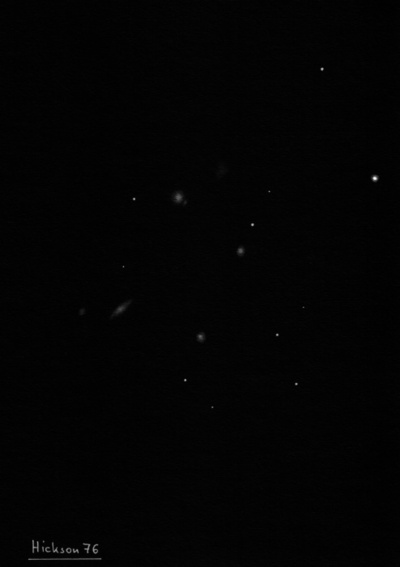
| Type | GALCL [S3] |
| RA | 15:31:41.9 |
| Dec | +07:18:29.0 |
| major_axis | 4.3' |
| mag | 12.3 |
| surface_bright | 99.9 |
HCG 75
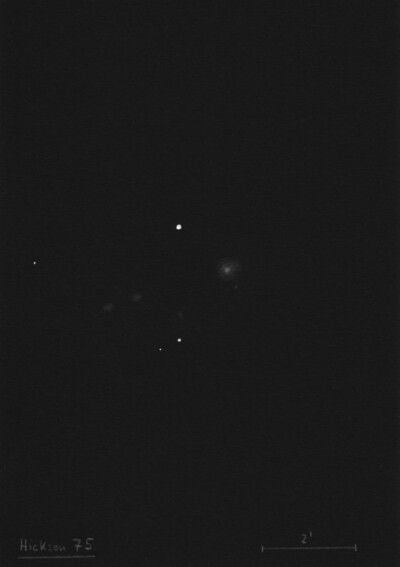
| Type | GALCL [E3] |
| RA | 15:21:33.8 |
| Dec | +21:11:00.0 |
| major_axis | 2.9' |
| mag | 12.4 |
| surface_bright | 99.9 |
M 1-33
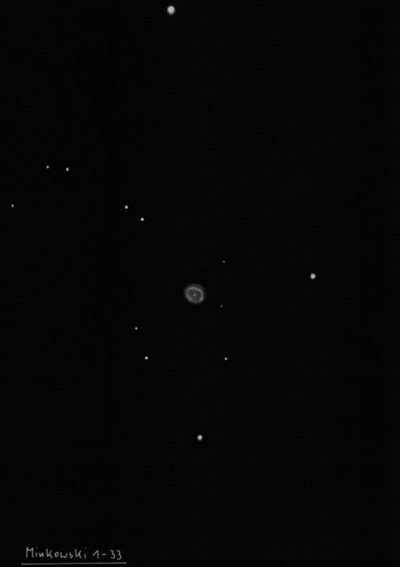
| Type | PN |
| RA | 17:58:58.8 |
| Dec | -15:32:15.0 |
| minor_axis | 48.0'' |
| mag | 13.7 |
| surface_bright | 8.0 |
HCG 77
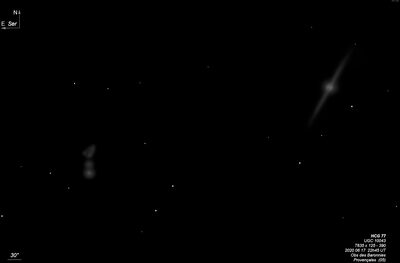
| Type | GALCL [E3] |
| RA | 15:49:17.2 |
| Dec | +21:49:42.0 |
| major_axis | 60.0'' |
| mag | 13.8 |
| surface_bright | 99.9 |
UGC 9755
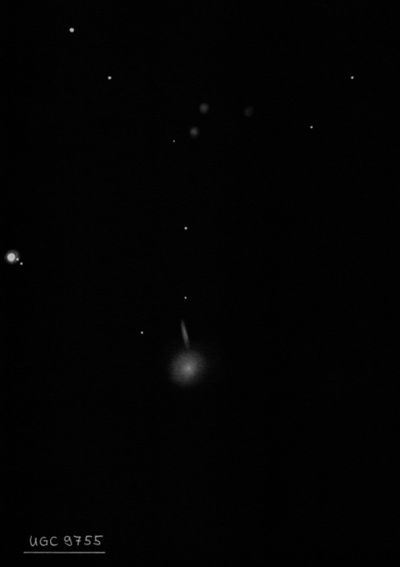
| Type | GX [Sc] |
| RA | 15:11:13.1 |
| Dec | +10:27:05.0 |
| major_axis | 66.0'' |
| minor_axis | 48.0'' |
| position_angle | 19.0 |
| mag | 14.3 |
| surface_bright | 14.1 |
M 2-44
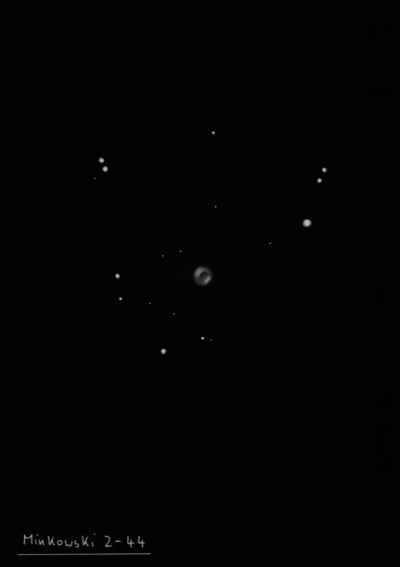
| Type | PN |
| RA | 18:37:37.0 |
| Dec | -03:05:57.0 |
| major_axis | 6.0'' |
| minor_axis | 18.0'' |
| position_angle | 1.0 |
| mag | 15.0 |
| surface_bright | 10.2 |
K 3-4
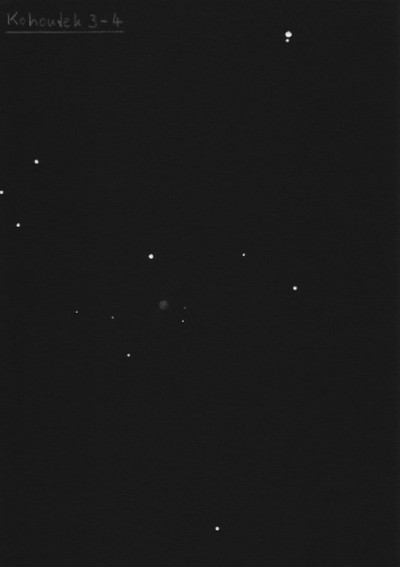
| Type | PN [3b(2)] |
| RA | 18:31:00.2 |
| Dec | +02:25:27.0 |
| major_axis | 18.0'' |
| mag | 15.7 |
| surface_bright | 13.0 |
M 4-9
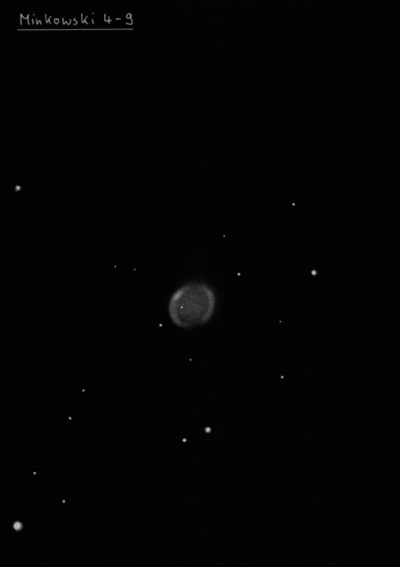
| Type | PN |
| RA | 18:14:18.4 |
| Dec | -04:59:22.0 |
| major_axis | 54.0'' |
| mag | 16.0 |
| surface_bright | 15.5 |
PGC 54559
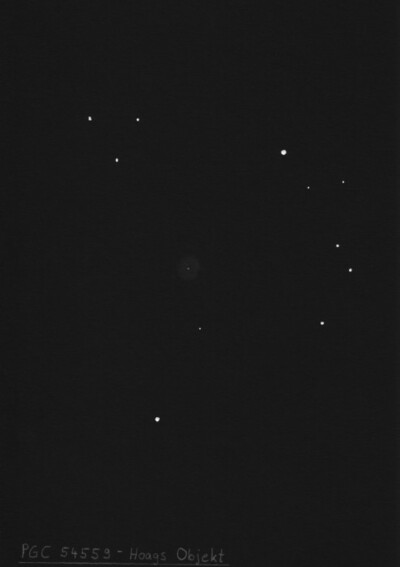
| Type | GX |
| RA | 15:17:13.7 |
| Dec | +21:35:03.0 |
| major_axis | 18.0'' |
| minor_axis | 12.0'' |
| mag | 16.1 |
Abell 41
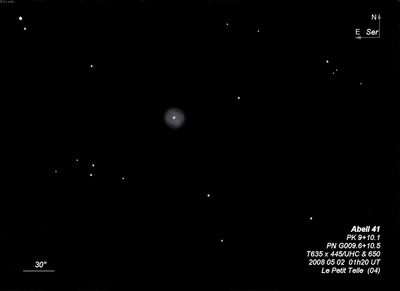
| Type | PN [3(2)] |
| RA | 17:29:02.0 |
| Dec | -15:13:04.0 |
| major_axis | 18.0'' |
| mag | 17.2 |
| surface_bright | 14.3 |
